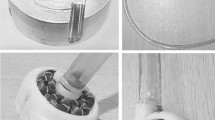Abstract
The aim of this work was to analyze a shrouded impeller pediatric ventricular assist device (SIP-VAD). This device has distinctive design characteristics and parameter optimizations for minimization of recirculation flow and reduction in high-stress regions that cause blood damage. Computational Fluid Dynamics (CFD) simulations were performed to analyze the optimized design. The bench-top prototype of SIP-VAD was manufactured with biocompatible stainless steel. A study on the hydrodynamic and hemodynamic performance of the SIP-VAD was conducted with predictions from CFD and actual experimentation values, and these results were compared. The CFD analysis yielded a pressure range of 29–90 mmHg corresponding to flow rates of 0.5–3 L/min over 9000–11000 rpm. The predicted value of the normalized index of hemolysis (NIH) was 0.0048 g/100 L. The experimental results with the bench-top prototype showed a pressure rise of 30–105 mmHg for the flow speed of 8000–12000 rpm and flow rate of 0.5–3.5 L/min. The maximum difference between CFD and experimental results was 4 mmHg pressure. In addition, the blood test showed the average NIH level of 0.00674 g/100 L. The results show the feasibility of shrouded impeller design of axial-flow pump for manufacturing the prototype for further animal trials.




Similar content being viewed by others
References
Benjamin EJ, Blaha MJ, Chiuve SE, Cushman M, Das SR, Deo R, de Ferranti SD, Floyd J, Fornage M, Gillespie C. Heart disease and stroke statistics—2017 update: a report from the American Heart Association. Circulation. 2017;135(10):e146-e603.
Wu J, Antaki JF, Verkaik J, Snyder S, Ricci M. Computational fluid dynamics-based design optimization for an implantable miniature Maglev pediatric ventricular assist device. J Fluids Eng. 2012;134(4):041101.
Almond CS, Thiagarajan RR, Piercey GE, Gauvreau K, Blume ED, Bastardi HJ, Fynn-Thompson F, Singh T. Waiting list mortality among children listed for heart transplantation in the United States. Circulation. 2009;119(5):717 – 27.
Okamoto E, Ishida Y, Yano T, Mitamura Y. Passive magnetic bearing in the 3rd generation miniature axial flow pump-the valvo pump 2. J Artif Organs. 2015;18(2):181–4.
Duncan BW, Lorenz M, Kopcak MW, Fukamachi K, Ootaki Y, Chen HM, Chapman PA, Davis SJ, Smith WA. The PediPump: a new ventricular assist device for children. Artif Organs. 2005;29(7):527 – 30.
Duncan BW. Mechanical circulatory support for infants and children with cardiac disease. Ann Thorac Surg. 2002;73(5):1670–7.
Baldwin JT, Adachi I, Teal J, Almond CA, Jaquiss RD, Massicotte MP, Dasse K, Siami FS, Zak V, Kaltman JR. Closing in on the PumpKIN trial of the Jarvik 2015 ventricular assist device. In: Seminars in thoracic and cardiovascular surgery: pediatric cardiac surgery annual. Elsevier, pp. 9–15 (2017).
Hsu C-H. Flow study on a newly developed impeller for a left ventricular assist device. J Artif Organs. 2003;6(2):92–100.
Su B, Chua LP, Lim TM, Zhou T. Evaluation of the impeller shroud performance of an axial flow ventricular assist device using computational fluid dynamics. Artif Organs. 2010;34(9):745 – 59.
Hara S, Maeno E, Li X, Yurimoto T, Isoyama T, Saito I, Ono T, Abe Y. Principle and basic property of the sequential flow pump. J Artif Organs. 2017:1–6.
Giersiepen M, Wurzinger L, Opitz R, Reul H. Estimation of shear stress-related blood damage in heart valve prostheses—in vitro comparison of 25 aortic valves. Int J Artif Organs. 1990;13(5):300–6.
Behbahani M, Behr M, Hormes M, Steinseifer U, Arora D, Coronado O, Pasquali M. A review of computational fluid dynamics analysis of blood pumps. Eur J Appl Math. 2009;20(04):363 – 97.
Pauli L, Nam J, Pasquali M, Behr M. Transient stress-based and strain-based hemolysis estimation in a simplified blood pump. Int J Numer Methods Biomed Eng. 2013;29(10):1148–60.
Gesenhues L, Pauli L, Behr M. Strain-based blood damage estimation for computational design of ventricular assist devices. Int J Artif Organs. 2016;39:166–70.
Garon A, Farinas MI. Fast three-dimensional numerical hemolysis approximation. Artif Organs. 2004;28(11):1016–25.
Gradwohl RBH, Sonnenwirth AC, Jarett L. Gradwohl’s clinical laboratory methods and diagnosis. 8th ed. St. Louis: Mosby; 1980.
Throckmorton AL, Kapadia JY, Chopski SG, Bhavsar SS, Moskowitz WB, Gullquist SD, Gangemi JJ, Haggerty CM, Yoganathan AP. Numerical, hydraulic, and hemolytic evaluation of an intravascular axial flow blood pump to mechanically support Fontan patients. Ann Biomed Eng. 2011;39(1):324 – 36.
Author information
Authors and Affiliations
Corresponding authors
Rights and permissions
About this article
Cite this article
Khan, T.I., Sheh Zad, H., Lazoglu, I. et al. Development of a novel shrouded impeller pediatric blood pump. J Artif Organs 21, 142–149 (2018). https://doi.org/10.1007/s10047-018-1028-3
Received:
Accepted:
Published:
Issue Date:
DOI: https://doi.org/10.1007/s10047-018-1028-3




